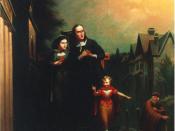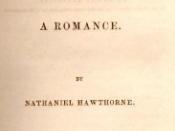In The Scarlet Letter by Nathaniel Hawthorne, the theme of the individual versus society is prevalent. One of the most intriguing characters in the novel is Hester Prynne, who is ostracized by the society around her. Hawthorne uses symbols to accentuate how Hester chooses to accept her branded punishment as a moral obligation rather than a mark of shame. Her individualism is achieved through a clear conscience and accepting the fact that she is unique, distanced from the Puritans surrounding her.
Immediately, The Scarlet Letter sets up a clear contrast between Hester and the other ladies in Boston, Massachusetts. Hester emerges from the prison as a gorgeous woman who was,
"tall, with a figure of perfect elegance on a large scale. She had dark and abundant hair, so glossy that it threw off the susnhine with a gleam, and a face which ,beside being beautiful from regularity of feature and richness of complexion...
was ladylike, too, after the manner of the feminine gentility of those days; characterized by a certain state and dignity." (Narrator, p. 46-47)
Meanwhile, the other women in Boston are portrayed as gossiping quacks who ridicule Hester out of jealousy and spite. Hester is further distanced from the mob throng through her elegant garb and her skill of needle-work.
While on the scaffold, and later when she moves into a cottage distanced from everyone else, Hester remains defiant. She asserts her quasi rebellious personality by not wavering amid the penetrating stares of the townspeople. In addition, she chooses to stay in Boston rather than take the opportunity to escape and start a new life. By running away, Hester would be acknowledging society's power of her. Instead, she desires to establish her own identity and not have society determine it for her. If Hester were to succumb...


